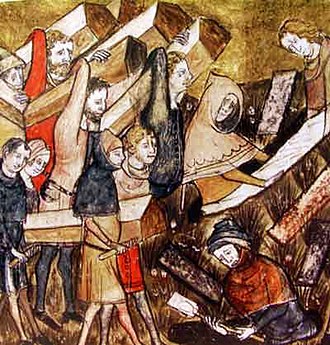Pandemic: Difference between revisions
12 |
m Reverted edits by 46.18.178.20 (talk) to last version by Nev1 |
||
| Line 1: | Line 1: | ||
[[File:Burying Plague Victims of Tournai.jpg|right|thumb|The burial of the victims of the plague in Tournai. Fragment of a miniature from "The Chronicles of Gilles Li Muisis" (1272-1352), abbot of the monastery of St. Martin of the Righteous. Bibliothèque royale de Belgique, MS 13076-77, f. 24v.]] |
[[File:Burying Plague Victims of Tournai.jpg|right|thumb|The burial of the victims of the plague in Tournai. Fragment of a miniature from "The Chronicles of Gilles Li Muisis" (1272-1352), abbot of the monastery of St. Martin of the Righteous. Bibliothèque royale de Belgique, MS 13076-77, f. 24v.]] |
||
A '''pandemic''' (from |
A '''pandemic''' (from [[Greek language|Greek]] παν ''pan'' all + δήμος ''demos'' people) is an [[epidemic]] (an outbreak of an [[infectious disease]]) that spreads across a large region (for example a continent), or even worldwide. |
||
== Common killers and pandemics == |
== Common killers and pandemics == |
||
Revision as of 14:16, 26 March 2015

A pandemic (from Greek παν pan all + δήμος demos people) is an epidemic (an outbreak of an infectious disease) that spreads across a large region (for example a continent), or even worldwide.
Common killers and pandemics
According to the World Health Organization, a pandemic can start when three conditions have been met:
- the emergence of a disease new to the population.
- the agent infects humans, causing serious illness.
- the agent spreads easily and sustainably among humans.
A disease or condition is not a pandemic merely because it is widespread or kills many people; it must also be infectious. For example cancer is responsible for many deaths but is not considered a pandemic because the disease is not infectious (although certain causes of some types of cancer might be).
World Health Organization pandemic phases
The World Health Organization (WHO) has developed a plan to prepare globally the fight against influenza. It defines the stages of a pandemic and makes recommendations for national measures before and during a pandemic. The phases are:
Interpandemic period:
- Phase 1: No new influenza virus subtypes have been detected in humans.
- Phase 2: No new influenza virus subtypes have been detected in humans, but an animal variant threatens human disease.
Pandemic alert period:
- Phase 3: Human infection(s) with a new subtype but no human-to-human spread.
- Phase 4: Small cluster(s) with limited localized human-to-human transmission
- Phase 5: Larger cluster(s) but human-to-human spread still localized.
Pandemic period:
- Phase 6: Pandemic: increased and sustained transmission in general population.
Related pages
References
- Steward's "The Next Global Threat: Pandemic Influenza".